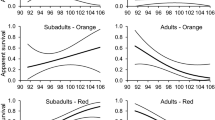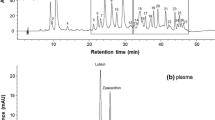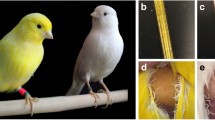Abstract
Sexual selection promotes the evolution of signals, many of which can reliably indicate condition, health or good genes of individuals. In order to be evolutionarily stable, indicator signals must be costly to produce. Carotenoid colouration evolved in many species by sexual selection. Carotenoids besides acting as pigments have been implicated in immune defence and antioxidation which makes them likely candidates for honest signalling. A trade-off for carotenoid availability was proposed as the basis for signal honesty. Alternatively, it was suggested that carotenoid colouration is not advertising the presence of the pigment per se, but the quality of antioxidant resources which then affect carotenoid concentration. One possibility is that carotenoid-based colouration could signal colourless antioxidant mechanisms, which are partially regulated by vitamins. β-Carotene is one of the most common precursors of vitamin A and, although present in bird diet, is not available for feather colouration. If an indirect association exists between carotenoid signal and condition, then manipulation of β-carotene concentration could reveal that this link is indirect. We tested this by conditioning the availability of β-carotene in the diet of a cardueline finch with yellow carotenoid colouration during moult. β-Carotene-supplemented males had higher plasma carotenoid concentration and higher response to a cellular immunity challenge (phytohaemagglutinin (PHA)) than control males. β-Carotene-supplemented males also had more saturated plumage colouration and were preferred by females in a mate choice test. Our results support the possibility of an indirect role for yellow carotenoid colouration.





Similar content being viewed by others
References
Aguilera E, Amat J (2007) Carotenoids, immune response and the expression of sexual ornaments in male greenfinches (Carduelis chloris). Naturwissenschaften 94:895–902
Alonso-Alvarez C, Bertrand S, Devevey G, Gaillard M, Prost J, Faivre B, Sorci G (2004) An experimental test of the dose-dependent effect of carotenoids and immune activation on sexual signals and antioxidant activity. Am Nat 164:651–659
Andersson M (1994) Sexual selection. Princeton University Press, Princeton
Baeta R, Faivre B, Motreuil S, Gaillard M, Moreau J (2008) Carotenoid trade-off between parasitic resistance and sexual display: an experimental study in the blackbird (Turdus merula). Proc R Soc Lond B 275:427–434
Behnke JM, McGregor PK, Shepherd M, Wiles R, Barnard C, Gilbert FS, Hurst JL (1995) Identity, prevalence and intensity of infestation with wing feather mites on birds (Passeriformes) from the Setubal Peninsula of Portugal. Exp Appl Acarol 19:443–458
Behnke J, McGregor P, Cameron J, Hartley I, Shepherd M, Gilbert F, Barnard C, Hurst J, Gray S, Wiles R (1999) Semi-quantitative assessment of wing feather mite (Acarina) infestations on passerine birds from Portugal. Evaluation of the criteria for accurate quantification of mite burdens. J Zool 248:337–347
Bendich A (1989) Symposium conclusions: biological actions of carotenoids. J Nutr 119:135–136
Bendich A, Olson JA (1989) Biological actions of carotenoids. FASEB J 3:1927–1932
Bertrand S, Alonso-Alvarez C, Devevey G, Faivre B, Prost J, Sorci G (2006a) Carotenoids modulate the trade-off between egg production and resistance to oxidative stress in zebra finches. Oecologia 147:576–584
Bertrand S, Faivre B, Sorci G (2006b) Do carotenoid-based sexual traits signal the availability of non-pigmentary antioxidants? J Exp Biol 209:4414–4419
Biard C, Surai PF, Møller AP (2006) Carotenoid availability in diet and phenotype of blue and great tit nestlings. J Exp Biol 209:1004–1015
Biesalski HK, Chichili GR, Frank J, von Lintig J, Nohr D (2007) Conversion of β-carotene to retinal pigment. In: Gerald L (ed) Vitamins & hormones, vol 75. Academic Press, San Diego, USA, p 117–130
Blas J, Perez-Rodriguez L, Bortolotti GR, Vinuela J, Marchant TA (2006) Testosterone increases bioavailability of carotenoids: insights into the honesty of sexual signaling. Proc Natl Acad Sci U S A 103:18633–18637
Blount JD (2004) Carotenoids and life-history evolution in animals. Arch Biochem Biophys 430:10–15
Blount JD, Surai PF, Houston DC, Møller AP (2001) The relationship between dietary and yolk carotenoid composition in a wild bird: a supplemental feeding study of lesser black-backed gulls (Larus fuscus). Br Poult Sci 42:S84–S85
Blount JD, Metcalfe NB, Arnold KE, Surai PF, Devevey GL, Monaghan P (2003) Neonatal nutrition, adult antioxidant defences and sexual attractiveness in the zebra finch. Proc R Soc Lond B 270:1691–1696
Bruzzone OA, Corley JC (2011) Which is the best experimental design in animal choice tests? Anim Behav 82:161–169
Chew BP (1993) Role of carotenoids in the immune response. J Dairy Sci 76:2804–2811
Chew BP, Park JS (2004) Carotenoid action on the immune response. J Nutr 134:257S–261S
Costantini D, Møller AP (2008) Carotenoids are minor antioxidants for birds. Funct Ecol 22:367–370
Cramp S, Perrins CM (eds) (1994) Handbook of the birds of Europe, the Middle East and North Africa—the birds of the Western Palearctic, vol VIII—crows to finches. Oxford University Press, Oxford
Cucco M, Guasco B, Malacarne G, Ottonelli R (2006) Effects of β-carotene supplementation on chick growth, immune status and behaviour in the grey partridge, Perdix perdix. Behav Process 73:325–332
D’Ambrosio DN, Clugston RD, Blaner WS (2011) Vitamin A metabolism: an update. Nutrients 3:63–103
Debier C, Larondelle Y (2005) Vitamins A and E: metabolism, roles and transfer to offspring. Br J Nutr 93:153–174
del Val E, Senar J, Garrido-Fernández J, Jarén M, Borràs A, Cabrera J, Negro J (2009) The liver but not the skin is the site for conversion of a red carotenoid in a passerine bird. Naturwissenschaften 96:797–801
El-Agamey A, Lowe GM, McGarvey DJ, Mortensen A, Phillip DM, Truscott TG, Young AJ (2004) Carotenoid radical chemistry and antioxidant/pro-oxidant properties. Arch Biochem Biophys 430:37–48
Endler J (1983) Natural and sexual selection on color patterns in poeciliid fishes. Environ Biol Fish 9:173–190
Evans JP, Kelley JL, Bisazza A, Finazzo E, Pilastro A (2004) Sire attractiveness influences offspring performance in guppies. Proc R Soc Lond B 271:2035–2042
Evans SR, Hinks AE, Wilkin TA, Sheldon BC (2010) Age, sex and beauty: methodological dependence of age- and sex-dichromatism in the great tit Parus major. Biol J Linn Soc 101:777–796
Faivre B, Préault M, Salvadori F, Théry M, Gaillard M, Cézilly F (2003) Bill colour and immunocompetence in the European blackbird. Anim Behav 65:1125–1131
Fenoglio S, Cucco M, Malacarne G (2002) The effect of a carotenoid-rich diet on immunocompetence and behavioural performances in Moorhen chicks. Ethol Ecol Evol 14:149–156
Figuerola J, Senar JC (2007) Serins with intermediate brightness have a higher survival in the wild. Oikos 116:636–641
Figuerola J, Domenech J, Senar JC (2003) Plumage colour is related to ectosymbiont load during moult in the serin, Serinus serinus: an experimental study. Anim Behav 65:551–557
Galluzzi L, Kepp O, Trojel-Hansen C, Kroemer G (2012) Mitochondrial control of cellular life, stress, and death. Circ Res 111:1198–1207
Goodwin TW (1984) The biochemistry of carotenoids, vol II, animals. Chapman & Hall, New York
Grafen A (1990) Biological signals as handicaps. J Theor Biol 144:517–546
Hart N, Partridge J, Cuthill I, Bennett A (2000) Visual pigments, oil droplets, ocular media and cone photoreceptor distribution in two species of passerine bird: the blue tit (Parus caeruleus L.) and the blackbird (Turdus merula L.). J Comp Physiol A 186:375–387
Hartley RC, Kennedy MW (2004) Are carotenoids a red herring in sexual display? Trends Ecol Evol 19:353–354
Hasselquist D, Nilsson J-Å (2012) Physiological mechanisms mediating costs of immune responses: what can we learn from studies of birds? Anim Behav 83:1303–1312
Håstad O, Victorsson J, Ödeen A (2005) Differences in color vision make passerines less conspicuous in the eyes of their predators. Proc Natl Acad Sci U S A 102:6391–6394
Hill GE (1990) Female house finches prefer colourful males: sexual selection for a condition-dependent trait. Anim Behav 40:563–572
Hill GE (1994) Geographic variation in male ornamentation and female mate preference in the House finch—a comparative test of models of sexual selection. Behav Ecol 5:64–73
Hill GE (1999) Is there an immunological cost to carotenoid-based ornamental coloration? Am Nat 154:589–595
Hill GE (2006) Female mate choice for ornamental coloration. In: Hill GE, McGraw K (eds) Bird coloration: function and evolution, vol II. Harvard University Press, London, pp 137–200
Hill GE, Johnson JD (2012) The vitamin A–redox hypothesis: a biochemical basis for honest signaling via carotenoid pigmentation. Am Nat 180:E127–E150
Hõrak P, Saks L (2003) Animal allure and health linked by plant pigments. BioEssays 25:746–747
Huggins K, Navara K, Mendonça M, Hill G (2010) Detrimental effects of carotenoid pigments: the dark side of bright coloration. Naturwissenschaften 97:637–644
Jakob E, Marshall S, Uetz G (1996) Estimating fitness: a comparison of body condition indices. Oikos 77:61–67
Johnson K, Rosetta D, Burley DN (1993) Preferences of female American goldfinches (Carduelis tristis) for natural and artificial male traits. Behav Ecol 4:138–143
Kopena R, López P, Martín J (2014) Relative contribution of dietary carotenoids and vitamin E to visual and chemical sexual signals of male Iberian green lizards: an experimental test. Behav Ecol Sociobiol 68:571–581
Krinsky NI (1989) Antioxidant functions of carotenoids. Free Radic Biol Med 7:617–635
Leitão AV, Monteiro AH, Mota PG (2014) Ultraviolet reflectance influences female preference for colourful males in the European serin. Behav Ecol Sociobiol 68:63–72
Lozano GA (1994) Carotenoids, parasites, and sexual selection. Oikos 70:309–311
Maia R, Eliason CM, Bitton PP, Doucet SM, Shawkey MD (2013) pavo: an R package for the analysis, visualization and organization of spectral data. Methods Ecol Evol 4:906–913
Martin LB, Han P, Lewittes J, Kuhlman JR, Klasing KC, Wikelski M (2006) Phytohemagglutinin-induced skin swelling in birds: histological support for a classic immunoecological technique. Funct Ecol 20:290–299
Martínez A, Rodríguez-Gironés MA, As B, Costas M (2008) Donator acceptor map for carotenoids, melatonin and vitamins. J Phys Chem A 112:9037–9042
McGraw K (2006) Mechanics of carotenoid-based coloration. In: Hill GE, McGraw K (eds) Bird coloration: mechanisms and measurements, vol I. Harvard University Press, London, pp 177–242
McGraw KJ, Ardia DR (2003) Carotenoids, immunocompetence, and the information content of sexual colors: an experimental test. Am Nat 162:704–712
McGraw KJ, Ardia DR (2005) Sex differences in carotenoid status and immune performance in zebra finches. Evol Ecol Res 7:251–262
McGraw KJ, Hill GE, Stradi R, Parker RS (2001) The influence of carotenoid acquisition and utilization on the maintenance of species-typical plumage pigmentation in male American goldfinches (Carduelis tristis) and Northern Cardinals (Cardinalis cardinalis). Physiol Biochem Zool 74:843–852
McGraw KJ, Hill GE, Parker RS (2005) The physiological costs of being colourful: nutritional control of carotenoid utilization in the American goldfinch, Carduelis tristis. Anim Behav 69:653–660
McWhinney SLL, Bailey CA (1989) Immunoenhancing effect of β-carotene in chicks. Poult Sci 68(suppl 1):94 (Abstr.)
Møller AP, Biard C, Blount JD, Houston DC, Ninni P, Saino N, Surai PF (2000) Carotenoid-dependent signals: indicators of foraging efficiency, immunocompetence or detoxification ability? Avian Poult Biol Rev 11:137–159
Mougeot F (2008) Ornamental comb colour predicts T-cell-mediated immunity in male red grouse Lagopus lagopus scoticus. Naturwissenschaften 95:125–132
Navara KJ, Hill GE (2003) Dietary carotenoid pigments and immune function in a songbird with extensive carotenoid-based plumage coloration. Behav Ecol 14:909–916
Navarro C, Pérez-Contreras T, Avilés J, McGraw K, Soler J (2010) Beak colour reflects circulating carotenoid and vitamin A levels in spotless starlings (Sturnus unicolor). Behav Ecol Sociobiol 64:1057–1067
Ninni P, Fd L, Saino N, Haussy C, Møller AP (2004) Antioxidants and condition-dependence of arrival date in a migratory passerine. Oikos 105:55–64
Nolan PM, Hill GE (2004) Female choice for song characteristics in the house finch. Anim Behav 67:403–410
Olson VA, Owens IPF (1998) Costly sexual signals: are carotenoids rare, risky or required? Trends Ecol Evol 13:510–514
Osorio D, Miklósi A, Gonda Z (1999) Visual ecology and perception of coloration patterns by domestic chicks. Evol Ecol 13:673–689
Ots I, Murumägi A, Hõrak P (1998) Haematological health state indices of reproducing great tits: methodology and sources of natural variation. Funct Ecol 12:700–707
Ots I, Kerimov AB, Ivankina EV, Ilyina TA, Hõrak P (2001) Immune challenge affects basal metabolic activity in wintering great tits. Proc R Soc Lond B 268:1175–1181
Pagani-Nuñez E, Senar JC (2012) Changes in carotenoid-based plumage colour in relation to age in European Serins Serinus serinus. Ibis 154:155–160
Pérez-Rodriguez L, Mougeot F, Alonso-Alvarez C, Blas J, Vinuela J, Bortolotti GR (2008) Cell-mediated immune activation rapidly decreases plasma carotenoids but does not affect oxidative stress in red-legged partridges (Alectoris rufa). J Exp Biol 211:2155–2161
Pérez-Rodriguez L, Mougeot F, Alonso-Alvarez C (2010) Carotenoid-based coloration predicts resistance to oxidative damage during immune challenge. J Exp Biol 213:1685–1690
Peters A, Delhey K, Denk AG, Kempenaers B (2004) Trade-offs between immune investment and sexual signaling in male mallards. Am Nat 164:51–59
Peters A, Magdeburg S, Delhey K (2011) The carotenoid conundrum: improved nutrition boosts plasma carotenoid levels but not immune benefits of carotenoid supplementation. Oecologia 166:35–43
Pike TW, Blount JD, Lindström J, Metcalfe NB (2007) Availability of non-carotenoid antioxidants affects the expression of a carotenoid-based sexual ornament. Biol Lett 3:353–356
R Development Core Team (2013) R: a language and environment for statistical computing. R Foundation for Statistical Computing, Vienna, http://www.R-project.org
Saino N, Ferrari R, Romano M, Martinelli R, Møller AP (2003) Experimental manipulation of egg carotenoids affects immunity of barn swallow nestlings. Proc R Soc Lond B 270:2485–2489
Saks L, Ots I, Hõrak P (2003) Carotenoid-based plumage coloration of male greenfinches reflects health and immunocompetence. Oecologia 134:301–307
Schulte-Hostedde AI, Zinner B, Millar JS, Hickling GJ (2005) Restitution of mass-size residuals: validating body condition indices. Ecology 86:155–163
Searcy WA, Nowicki S (2005) The evolution of animal communication: reliability and deception in signaling systems. Princeton University Press, Princeton
Simons MJP, Verhulst S (2011) Zebra finch females prefer males with redder bills independent of song rate—a meta-analysis. Behav Ecol 22:755–762
Simons MJP, Cohen AA, Verhulst S (2012) What does carotenoid-dependent coloration tell? Plasma carotenoid level signals immunocompetence and oxidative stress state in birds—a meta-analysis. PLoS One 7:e43088
Smits JE, Bortolotti GR, Tella JL (1999) Simplifying the phytohaemagglutinin skin-testing technique in studies of avian immunocompetence. Funct Ecol 13:567–572
Stillwell W, Nahmias S (1983) Effect of retinol and retinoic acid on P/O ratios of coupled mitochondria. Biochem Int 6:385–392
Stradi R, Celentano G, Nava D (1995a) Separation and identification of carotenoids in bird’s plumage by high-performance liquid chromatography-diode-array detection. J Chromatogr B 670:337–348
Stradi R, Celentano G, Rossi E, Rovati G, Pastore M (1995b) Carotenoids in bird plumage-I. The carotenoid pattern in a series of Palearctic Carduelinae. Comp Biochem Physiol B 110:131–143
Sundberg J (1995) Female yellowhammers (Emberiza citrinella) prefer yellower males: a laboratory experiment. Behav Ecol Sociobiol 37:275–282
Surai AP (2002) Natural antioxidants in avian nutrition and reproduction. Nottingham University Press, Nottingham
Tella JL, Lemus JA, Carrete M, Blanco G (2008) The PHA test reflects acquired T-cell mediated immunocompetence in birds. PLoS One 3:e3295
Toomey M, McGraw K (2012) Mate choice for a male carotenoid-based ornament is linked to female dietary carotenoid intake and accumulation. BMC Evol Biol 12:3
von Lintig J (2010) Colors with functions: elucidating the biochemical and molecular basis of carotenoid metabolism. Annu Rev Nutr 30:35–56
Vorobyev M, Osorio D, Bennett A, Marshall N, Cuthill I (1998) Tetrachromacy, oil droplets and bird plumage colours. J Comp Physiol A 183:621–633
West AP, Shadel GS, Ghosh S (2011) Mitochondria in innate immune responses. Nat Rev Immunol 11:389–402
Zahavi A (1975) Mate selection-a selection for a handicap. J Theor Biol 53:205–214
Acknowledgments
We are grateful to Marta Costa for her field assistance, to Licínio Manco for lab help and to Antónia Conceição, from ESAC, for the supply of sheep blood. We also thank Jim Johnson and two anonymous reviewers for useful comments. This work was supported by a research grant (PTDC/BIA-BEC/105325/2008) to PGM and a PhD fellowship (SFRH/BD/44837/2008) to ST, both by Fundação para a Ciência e a Tecnologia.
Ethical standards
All experiments were performed in accordance to Portuguese legislation for research on animal behaviour and were conducted under license permits: 258/2009/CAPT to PGM and 259/2009/CAPT to ST, by Instituto da Conservação da Natureza e da Biodiversidade (ICNB).
Author information
Authors and Affiliations
Corresponding author
Additional information
Communicated by K. McGraw
Rights and permissions
About this article
Cite this article
Trigo, S., Mota, P.G. What is the value of a yellow patch? Assessing the signalling role of yellow colouration in the European serin. Behav Ecol Sociobiol 69, 481–490 (2015). https://doi.org/10.1007/s00265-014-1860-2
Received:
Revised:
Accepted:
Published:
Issue Date:
DOI: https://doi.org/10.1007/s00265-014-1860-2




